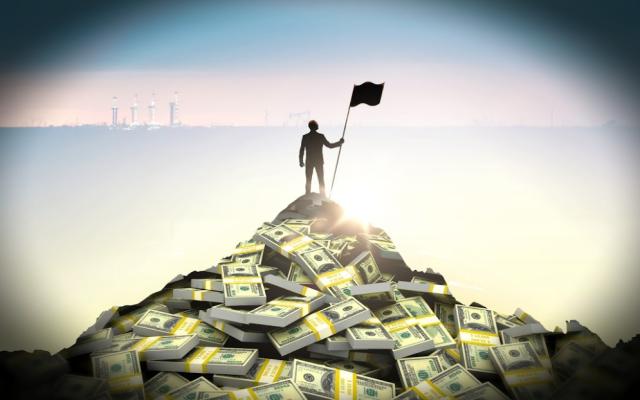
Maybe E&Ps can have their growth and enjoy their returns too, writes Steve Toon, Editor-in-Chief of Oil and Gas Investor, in his monthly column. (Source: Hart Energy/Shutterstock.com)
[Editor's note: A version of this story appears in the September 2019 edition of Oil and Gas Investor. Subscribe to the magazine here.]
It’s ironic, really, that in an age when E&Ps are promising coy investors that they will behave more grown-up and spend within cash flow, that first-quarter 2019 proved the worst outspend in two years. That’s according to the folk at Wood Mackenzie in a late-July report titled, “Is Tight Oil on the Verge of Sustained Free Cash Flow Generation?”
WoodMac reported that the outspend by tight oil independents reached $1.58 billion in the first quarter, the most since third-quarter 2017 when WTI averaged $48 per barrel, and compared with “just” $360 million of red ink year-over-year. But they had good reason, the analysts defended: E&Ps sought to take advantage of weakened service rates while oil was on an upswing.
“The increase in WTI at the start of the year presented a rare opportunity for companies to accelerate activity in the midst of relatively low service pricing.” That outspend trend might play out again in second-quarter numbers too once they’re all in. “U.S. independents may choose to continue to invest heavily in 2Q since the window to lock in lower costs is still open.”
So WoodMac ponders out loud, “Will tight oil ever generate consistent free cash flow?” The prognosticators surmise “yes” despite the apparent seeming lack of capital discipline.
“The promise of massive cash flow from tight oil has always been just around the corner,” the report said, “but what makes today different is the level of capital discipline exhibited across the industry, a much larger base of production generating cash flow, a depressed service pricing environment and an unwillingness of the public capital markets to fund tight oil.”
By locking in lower costs in first quarter, this will boost returns and NPV. “The investment strategy should help support free-cash-flow generation in the second half of the year,” the authors concluded, but added, “assuming investment is subsequently dialed back.”
Well, that’s the big question, isn’t it?
Raymond James analyst John Freeman believes it will be so. In a July 29 research report, he noted operators planned for the front-loaded capex at the beginning of the year, with the intent to trim back as new production comes on. “We firmly believe that second-half spending will be reined in significantly,” he said, “allowing the vast majority of our (covered) operators to spend within budget.”
Freeman projected RayJay’s coverage group will underspend free cash flow in 2020 by 5%, with budgets set to break even at $50 to $55 oil. And any outspend will come at a penalty to the company’s shares.
“One thing that is certainly understood, by both operators and energy investors, is that any increase in spending in this environment will come at a high cost to a company’s stock price. In this new environment, capital discipline and shareholder returns are at the forefront of management priorities,” he said, “while production growth … is more of a secondary concern.”
He noted that operators wryly ask, “Why grow when you get no credit for it?” and that “the market is ready to reward returns to shareholders.”
But the growth-is-bad-pay-your-shareholder-first mantra might be foolhardy advice, per one contrarian analyst. David Heikkinen, namesake of Heikkinen Energy Advisors, said in a July 11 note that investors should be careful what they ask for. Looking at a basket of Permian E&P peers, he concluded, “We believe reduced growth expectations have played a key role in derating the peer group.”
The bigger question, he said, is whether or not the sector is adding value, defined by generating returns above the cost of capital. “While the focus has been on increasing payout as a positive driver of valuation multiples, payout also negatively impacts growth, which is a large driver of net asset valuation and multiples.”
Operators that believe they are returning above their cost of capital but acquiesce to calls to increase shareholder payout while sacrificing growth are short-sighted, he suggested. Their actions imply their returns are “inadequate to justify higher levels of reinvestment.”
He urges, “If you, E&P operator or investor, are confident in your E&P company’s ability to add value, then don’t abandon growth just yet—that should be the job of those with the lowest returns.”
Regardless of payout, “higher returns will drive higher growth, which drives a higher multiple,” he argued. “As such, we believe focusing on returns via things that are controllable and durable (i.e. capturing quality resources at peer-leading capital costs, drilling and completing wells as cheaply and efficiently as possible, hammering on operating costs and managing leverage), will be the most lasting means to achieving and maintaining a premium through the cycle.”
So maybe growth vs. returns isn’t the dichotomy it’s presented as by the investment community. Maybe you can have your growth and enjoy your returns too.
Recommended Reading
BP Restructures, Reduces Executive Team to 10
2024-04-18 - BP said the organizational changes will reduce duplication and reporting line complexity.
Matador Resources Announces Quarterly Cash Dividend
2024-04-18 - Matador Resources’ dividend is payable on June 7 to shareholders of record by May 17.
EQT Declares Quarterly Dividend
2024-04-18 - EQT Corp.’s dividend is payable June 1 to shareholders of record by May 8.
Daniel Berenbaum Joins Bloom Energy as CFO
2024-04-17 - Berenbaum succeeds CFO Greg Cameron, who is staying with Bloom until mid-May to facilitate the transition.
Equinor Releases Overview of Share Buyback Program
2024-04-17 - Equinor said the maximum shares to be repurchased is 16.8 million, of which up to 7.4 million shares can be acquired until May 15 and up to 9.4 million shares until Jan. 15, 2025 — the program’s end date.





